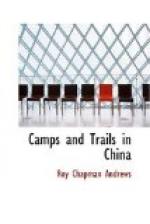The Kachin women were the most picturesque of all the tribes as well as the most difficult to photograph. Yvette was not able to get them at all, and I could do so only by strategy. When Wu discovered two or three squatting near their baskets on the ground I moved slowly up behind them keeping in the center of the crowd. After the “movie camera” was in position Wu suddenly “shooed” back the spectators and before the women realized what was happening they were registered on twenty-five or thirty feet of film.
One of the Kachin men, who had drunk too much, suddenly became belligerent when I pointed the camera in his direction, and rushed at me with a drawn knife. I swung for his jaw with my right fist and he went down in a heap. He was more surprised than hurt, I imagine, but it took all of the fight out of him for he received no sympathy from the spectators.
Poor Yvette had a difficult time with her camera operations and a less determined person would have given up in despair. The natives were so shy and suspicious that it was well-nigh impossible to bribe them to stand for a second and it was only after three hours of aggravating work in the stifling heat and dust that she at last succeeded in exposing all her plates. Her patience and determination were really wonderful and I am quite sure that I should not have obtained half her results.
The Kachin women were extraordinary looking individuals. They were short, and strongly built, with a mop of coarse hair cut straight all around, and thick lips stained with betel nut. Their dress consisted of a short black jacket and skirt reaching to the knees, and ornamented with strings of beads and pieces of brass or silver. This tribe forms the largest part of the population in northern Burma and also extends into Assam. Yuen-nan is fortunate in having comparatively few of them along its western frontier for they are an uncivilized and quarrelsome race and frequently give the British government considerable trouble.
There were only a few Burmans in the market although the border is hardly a dozen miles to the west, but the girls were especially attractive. Their bright pretty faces seemed always ready to break into a smile and their graceful figures draped in brilliant sarongs were in delightful contrast to the other, not over-clean, natives.
The Burma girls were not chewing betel nut, which added to their distinction. The lips of virtually every other woman and man were stained from the red juice, which is in universal use throughout India, the Malay Peninsula, and the Netherlands Indies. In Yuen-nan we first noted it at the “Good Hope” camp, and the Shans are generally addicted to the practice.
The permanent population of Meng-ting is entirely Shan, but during the winter a good many Cantonese Chinamen come to gamble and buy opium. The drug is smuggled across the border very easily and a lucrative trade is carried on. It can be purchased for seventy-five cents (Mexican) an ounce in Burma and sold for two dollars (Mexican) an ounce in Yuen-nan Fu and for ten dollars in Shanghai.




